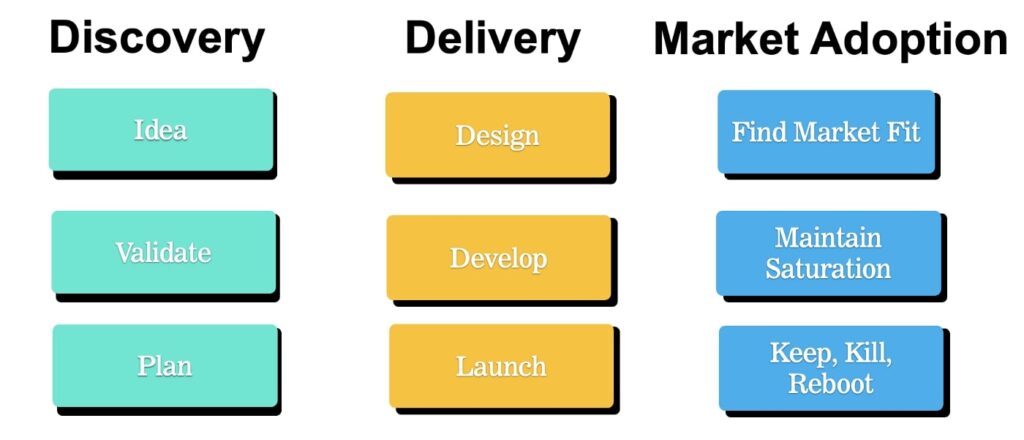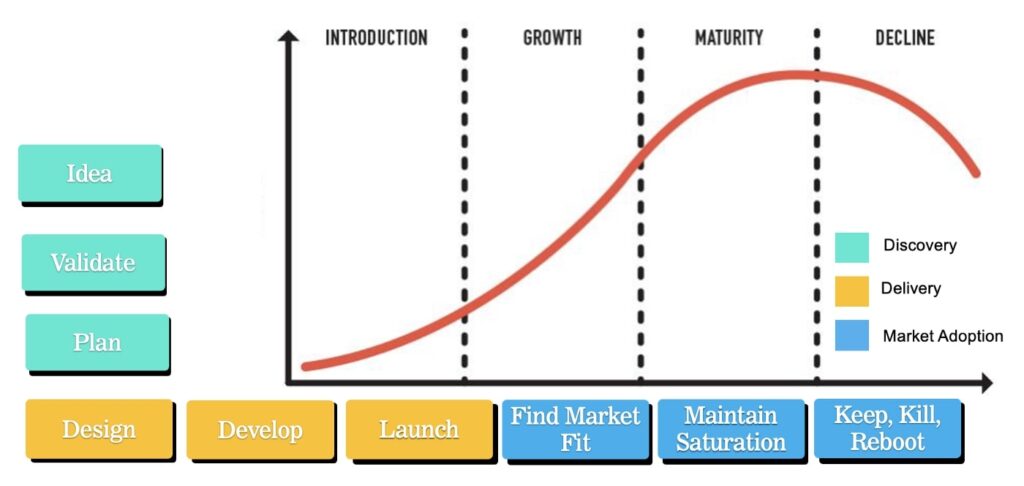Product Management Process that Supports Growth and Efficiency.
Fredrick Minah
As we learned in the previous mission, all products go through three phases:
Discovery – Figuring out what to build.
Delivery – Building and launching a product.
Market Adoption – Finding market fit.


Note: There is no universal playbook for the product management process. Processes evolve and adapt to the organisation, but the basic order of operations is fairly similar.
A company might be working on multiple product features and products at the same time, thus the process is not always linear and might overlap.
1. Discovery
Ideation and Vision Development
”Everything begins with an idea” – Earl Nightingale
Ideas can come from anywhere as a Product Manager. From internal stakeholders, speaking with customers, competitor activities and team brainstorming sessions. A Product Managers role is to capture and triage ideas and decide if it is worth solving.
For example, someone in Airbnb must have come up with the idea of having online experiences when the Covid-19 crisis hit. It allows for a new way for people to travel virtually and earn income while also creating a new revenue stream for Airbnb.
Product Vision gives the team a bigger picture of what they are working on and why. When developing the vision, a product manager sets the goals for the product and defines specifications.
For example, Amazon’s vision is “to be Earth’s most customer-centric company, where customers can find and discover anything they might want to buy online, and endeavors to offer its customers the lowest possible prices.”
2. Validating Ideas
In this phase, your job is to validate ideas.
Product Managers make decisions on which idea goes into the product roadmap by validating:
- the customer problem,
- market demand
- and the solution
A Product Manager will use various methods to validate ideas by using quantitative and qualitative data. We will study them in detail in Modules 2 & 3.
3. Strategy and Planning
While a vision defines the goals for a product, strategy describes a way to achieve them and sets main milestones. The strategy must be a clear and realistic plan for the team that works on the product.
The Product Manager makes decisions on the product strategy to highlight what needs to be built.
The product strategy will contain the following information:
- The problem
- The customer
- Market competition
- Product vision
- High-level concepts
- Financial model* (forecast of users and revenue)
- Delivery Milestones
- Start with a simple business model. Iterate on this when you get real customers using your product.
Delivery Phase
4. Design and Development
In the design phase, designers come in strong. The Product Manager works with them to create mock-ups. They meet with customers and get their feedback on what works and what doesn’t, and the mock-ups are tested with customers. This process is repeated until there is a well-defined product that solves key problems for customers.
In the delivery phase, the product manager coordinates with different teams (developers, engineers, and project managers) to manage product delivery.
Product Managers help break down features and prioritize product delivery, they sign off on final designs and technical solutions and write documentation to track changes over time.
5. Product / Feature Launch
The product Manager makes decisions on the go-to-market strategy in collaboration with the marketing team. Usually, before development is completed.
Decide which marketing collaterals, FAQs, training materials and other artefacts need to be updated.
Decide which bugs and issues will get addressed during the launch and which can be a future item.
Work with the business to decide on different launch phases to reduce company risk.
Market Adoption
6. Iterate to find Product-Market Fit
fter the product launch, the product manager monitors its progress and analyses data to understand the success of a product.
They track various metrics to understand revenue, user engagement and satisfaction, and product popularity.
Metrics show Product Managers how the product is performing and if any changes are required. Changes could involve adding new features, adjusting the sales or marketing campaign, etc.
According to Marc Andreessen, product-market fit is: “Being in a good market with a product that can satisfy that market.”
Product Managers make decisions on which problems will take the product to the next phase of growth.
7. Maintain Saturation
All products will eventually mature, and growth will slow down. You’ll need to focus on big impact features as feature launch will require more effort.
As a Product Manager, you need to maintain your market dominance and keep a close eye on your retention metrics.
Product Managers decide which initiatives to focus on to drive engagement and retention and features to add to reduce cost and scale the product.
8. Keep, Kill, Reboot
Eventually, your product will see a decline — it can come quickly or slowly. All products go through this phase so you’ll need to prepare for it.
Product Managers make decisions on one of the following:
a. Keeping the product in the market — If the product is stable, maintain it in the market without investing in major new features.
b. Kill off the product — If the product is not successful, consider sunsetting the product by:
Transition users to an alternative you create or to a partner
Terminate the product and support users along the way.
c. Reboot the product — Most of the time, the product is still solving the same problem – Work with your team to rediscover new technologies and user experiences. Microsoft office is an excellent example of a suite of products that moved from boxed software to mobile apps, to a cloud web app.